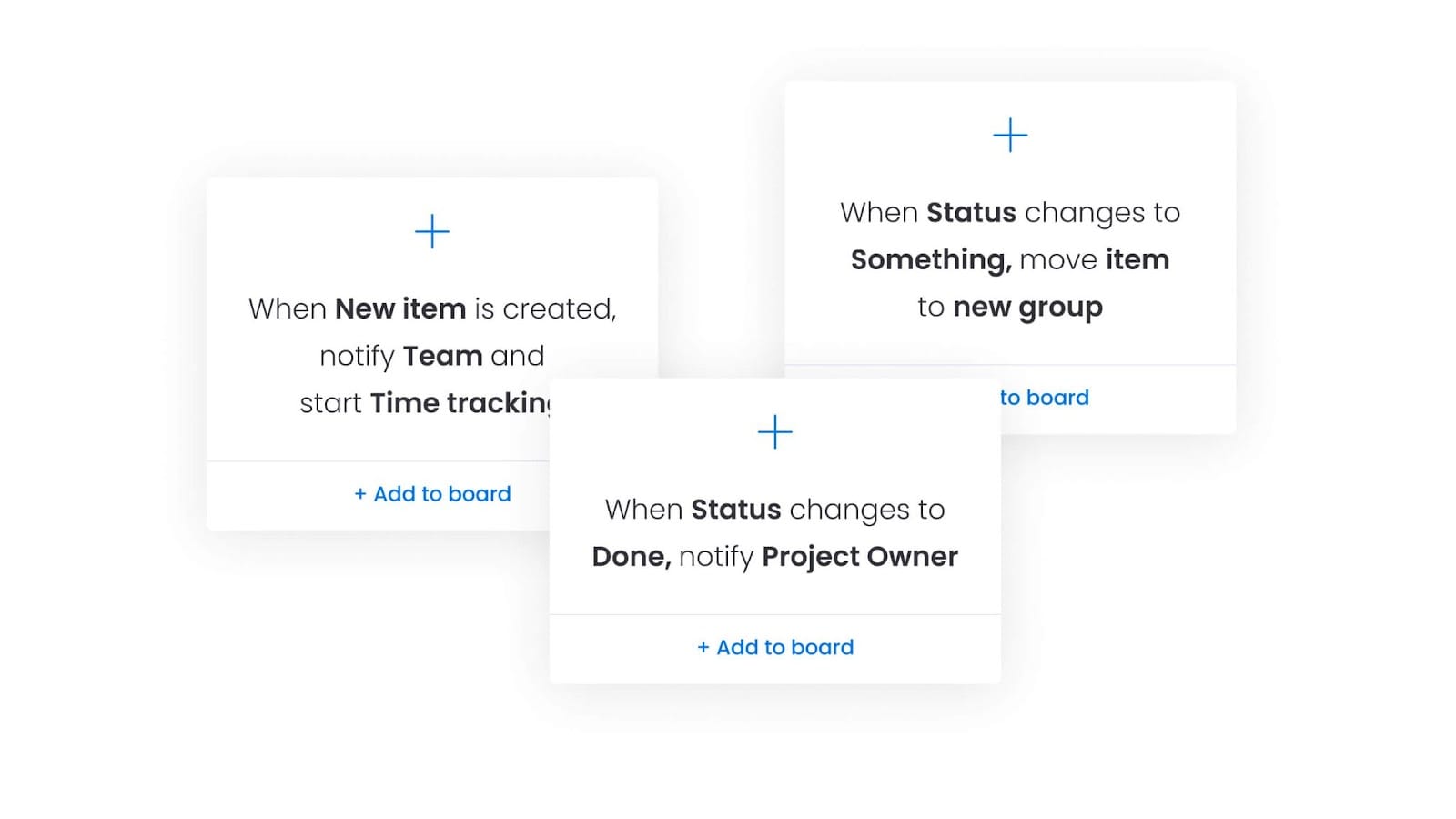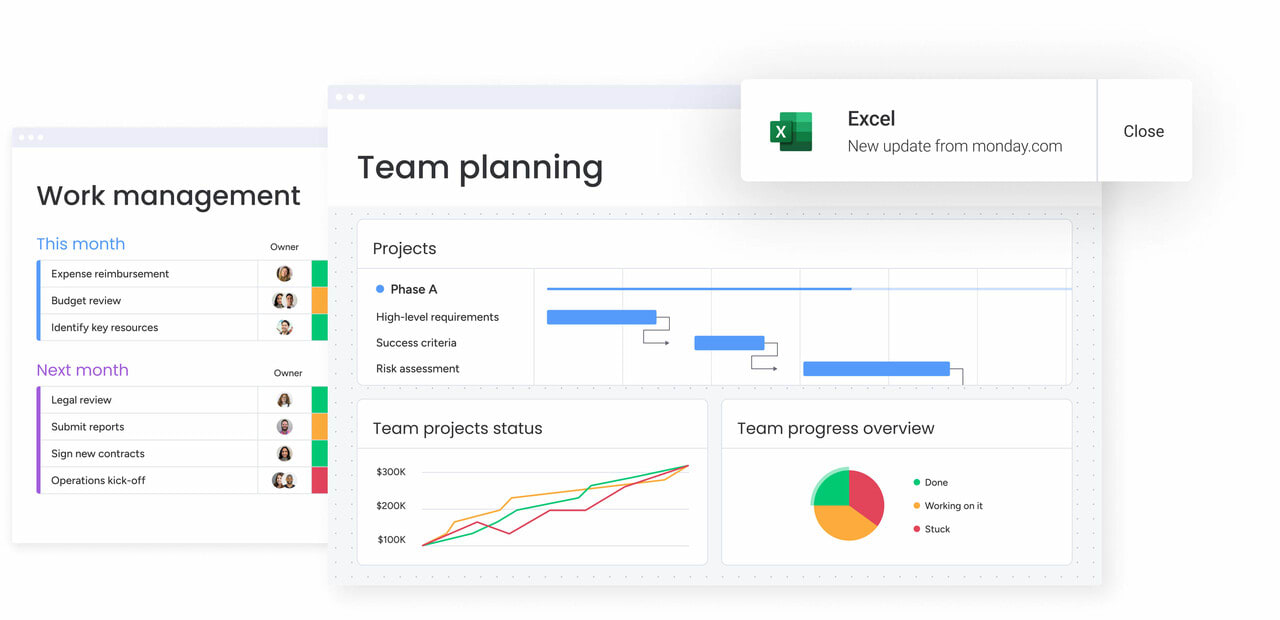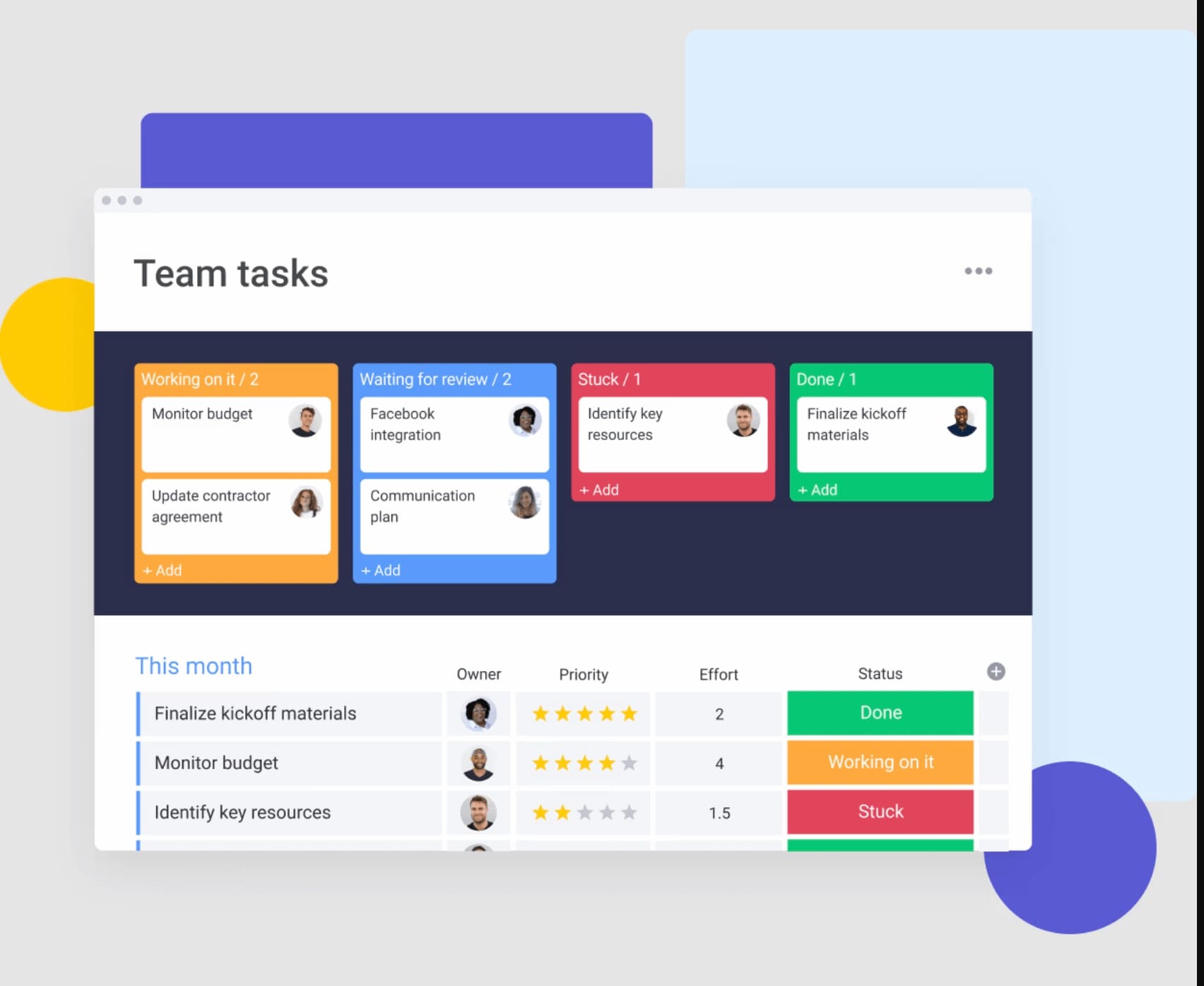To achieve strategic goals, the project management software your team uses can make all the difference. Both monday work management and Wrike are leading project management tools, but their capabilities, focus, and features cater to different needs. In this guide, we’ll compare the two platforms to help you decide which is better suited for your project managers and team workflows.
Expect a detailed breakdown of features, pricing, ease of use, integrations, customer reviews, and security — everything you need to make an informed decision for managing complex projects and optimizing team productivity.
monday work management vs. Wrike at a glance
Here’s a quick comparison of key features, pricing, and ratings for monday work management and Wrike.
| Feature | monday work management | Wrike |
|---|---|---|
| Pricing | From $9/user/month | From $10/user/month |
| Free plan | Yes, up to 2 users | Yes, up to 5 users |
| Popular features | Advanced automations, 200+ templates, cross-functional collaborations | Gantt charts, custom workflows, time tracking |
| Integrations | 200+ | 100+ |
| Ease of use | 32% of users highlighted ease of use (G2) | 9% of users highlighted ease of use (G2) |
| Customer reviews | 4.7/5 (G2) | 4.2/5 (G2) |
monday.com vs. Wrike: features
Both monday work management and Wrike offer robust task management tools, but how do they compare in handling complex projects, integrations, and collaboration?
monday work management features
monday work management is a dynamic project management software that helps teams manage project boards, automate workflows, and collaborate — all in real time.
What key features does monday work management offer?
- Customizable workflows: Build processes tailored to your team’s specific business needs — no technical expertise required.
- 200+ templates: Access a wide range of project templates for HR, marketing, sales, IT, and more to get started quickly.
- Multiview dashboards: Visualize projects through Kanban boards, Gantt charts, calendars, timelines, and maps, offering flexibility for your project managers.

- Advanced automations: Eliminate repetitive tasks and boost productivity with intuitive automation tools.

- Centralized collaboration: Store files, updates, and feedback in one place to enhance real-time team communication and decision-making.

- Seamless integrations: Connect with more than 200 tools, such as Slack, Salesforce, and Google Workspace, ensuring your project management tools work together effortlessly.
Wrike features
Wrike is a project management software designed for teams focused on traditional task and project workflows.
What key features does Wrike offer?
- Gantt charts: Create visual timelines to plan and track project schedules efficiently.
- Task dependencies: Manage relationships between tasks to prioritize work and streamline execution.
- Time tracking feature: Monitor how much time your team spends on specific tasks to improve productivity.
- Custom workflows: Set predefined processes to align with project requirements for smooth execution.
- Limited integrations: Use around 100 integrations with tools like Jira and Microsoft Teams, which is fewer options compared to monday work management.
Customer reviews: comparing monday work management and Wrike on G2
Customer feedback offers valuable insight into how teams benefit from each platform.
monday work management on G2
- Rating: 4.7/5 (12,800+ reviews)
- Highlights:
- Intuitive interface that encourages adoption
- Flexible templates and workflows
- Excellent support and scalability
What users say:
“monday work management has completely changed the way we work. in the best way. We first started using monday.com 3 years ago for task management … Now, we do pretty much all of our task management internal review processes/campaign management in monday.com. Boards are incredibly easy to set up, edit, and customize. Pretty much everything in monday.com is very user-friendly and intuitive. Everyone on our team loves it.” — G2 Review
Wrike on G2
- Rating: 4.2/5 (3,700+ reviews)
- Highlights:
- Robust project management features
- Effective task tracking
- Customizable visualization capabilities
What users say:
“Wrike has been transformational for our team. We love how we can cater workspaces to the working needs of any individual on our team. We also love how user-friendly it is compared to other programs, like Salesforce or Microsoft Project. We also love the customizable visualization features in dashboards and calendars. It feels like every time someone asks if Wrike can do what they want, the answer is yes!” — G2 Review
monday.com vs. Wrike: pricing
Pricing is a crucial consideration when choosing the right project management platform. It’s equally important to assess the value and features delivered by each plan. Here’s a breakdown of the pricing options for monday work management and Wrike.
Wrike pricing
Wrike offers a tiered structure, with each plan building on the previous one and adding new features tailored to different business needs.
- Free: Supports up to 5 users but comes with limited features, lacking Gantt charts and advanced customizations.
- Professional: $10 per user per month for teams of 5–200 users, which includes Gantt charts but lacks key features like workflow automation.
- Business: $24.80 per user per month for teams of 5–200 users, which includes custom fields, resource management, and time tracking but incurs additional costs for specific tools.
- Enterprise: Wrike has custom pricing for large organizations, which includes enhanced security, more storage, and advanced analytics.
monday work management pricing
Offering a 14-day free trial (no credit card required), monday work management offers flexible plans designed to scale with your organization:
- Free: At $0 for up to 2 users, this level includes mobile apps, 20+ column types, collaboration tools, 200+ templates, and whiteboard features.
- Basic: For $9 per user per month, this pricing includes unlimited users, 5GB of storage, unlimited boards, free viewers, and custom fields.
- Standard: At $12 per user per month, you get 20GB of storage, 6-month activity logs, 250 automations/month, guest access, and expanded collaboration options.
- Pro: For $19 per user per month, you gain 100GB of storage, a 1-year activity log, advanced time tracking, and workflow automation.
- Enterprise: For large organizations, there is custom pricing featuring enhanced admin controls, resource management, 5-year activity logs, and dedicated customer success managers.
Read more: monday work management pricing
Key differences in pricing
- Free plans: monday work management’s free plan provides access to more versatile features like templates and collaboration tools, while Wrike’s free plan supports more users but lacks depth.
- Additional file storage: monday work management’s Basic plan offers 5GB of file storage compared to Wrike’s Team plan with only 2GB.
- Advanced features: All of monday work management’s plans include features like workflow automation, while Wrike charges extra for these capabilities.
- Customization: monday work management plans offer customization based on the features offered instead of by team size like Wrike.
monday.com vs. Wrike: customer support
Exceptional support is critical when using a project management platform. Let’s see how monday work management and Wrike handle customer service.
Wrike customer support
Wrike’s support depends on your pricing plan, but here are some additional details:
- Availability: Standard support operating hours and availability depend on your chosen Wrike support package.
- Enterprise support: Organizations receive 24/7 assistance for higher-tier plans at an additional cost.
- Additional resources: Wrike provides a knowledge base, tutorials, and on-demand guides to help teams navigate the platform.
monday work management customer support
monday work management provides comprehensive support for all users:
- Availability: 24/7 support through live chat, email, and phone ensures immediate assistance.
- Enterprise support: Organizations receive a dedicated customer success manager for personalized guidance.
- Additional resources: Customers gain access to an extensive help center, daily live webinars, on-demand training videos, and an active community for peer support.
Why it matters: monday work management’s round-the-clock availability, paired with tailored enterprise-grade support, ensures that teams at every level can overcome challenges and maximize platform value without delays.
monday.com vs. Wrike: integrations
Integrations expand the capabilities of project management solutions by enabling seamless connections to the tools your team already uses. Let’s compare how monday work management and Wrike support integrations.
Wrike integrations
Wrike supports more than 100 integrations — primarily focused on project management-related apps — to help teams manage project progress effectively. Here are some of the integrations available with Wrike:
- Communication: Slack, Microsoft Teams
- Development tools: Jira, GitHub
- Data management: Excel, Google Sheets
Although sufficient for basic project workflows, Wrike may not offer the depth or breadth of integrations needed to support creative teams, marketing teams, or cross-functional collaboration.
monday work management integrations
Supporting 200+ third-party apps, monday work management delivers unmatched flexibility for teams across all business functions. Here are just some of the integrations available with monday work management:
- Communication: Slack, Microsoft Teams, Gmail, Outlook
- Collaboration: Google Drive, DocuSign
- Marketing teams: Mailchimp
- CRM & finance: Salesforce, HubSpot
- Development tools: GitLab, Jira
- Productivity: Google Calendar, Todoist
- Data management: Excel, Google Sheets
- Custom API: For teams with unique requirements, monday work management’s open API allows for tailored integrations that meet specific workflow needs.
Why it matters: With a broader range of integrations, monday work management ensures creative teams, marketing teams, and cross-functional groups can connect their tools, streamline collaboration, and maintain visibility into project progress.
monday.com vs. Wrike: security
Security is a critical factor when evaluating project management solutions, particularly for teams handling sensitive business data. Here’s how monday work management and Wrike ensure data protection.
Wrike security
Wrike adheres to essential compliance standards to protect user data:
- ISO certifications: ISO/IEC 27001 and 27017
- SOC compliance: SOC2 and SOC3
- Regulations: GDPR and HIPAA
Although Wrike meets standard security requirements, its certifications are less comprehensive compared to monday work management.
monday work management security
monday work management takes a more comprehensive approach to security, ensuring robust protection for all users:
- ISO certifications: ISO/IEC 27001, 27017, 27018, and 27032
- SOC compliance: SOC1, SOC2, and SOC3
- Regulations: GDPR, HIPAA, and CSA (Cloud Security Alliance)
Why it matters: Prioritizing compliance with stringent international standards, monday work management’s enhanced security framework provides teams with peace of mind. Whether you’re crafting a business plan, managing resources, or coordinating workflows, you can trust monday work management to protect and safeguard your data.
monday.com vs. Wrike for enterprises

Choosing the right project management platform depends on your organization’s goals, team size, and workflow complexity. Let’s explore how monday work management and Wrike compare in delivering enterprise-ready features for Agile project management, larger projects, and more.
Templates designed to power every enterprise team
Templates simplify workflows and provide a strong foundation for managing larger projects, but the range and flexibility of these templates can vary.
- Wrike: It offers a selection of project management templates tailored to Agile workflows, marketing teams, and basic project needs. However, access to these templates is limited on lower-tier plans, restricting scalability and customization for broader enterprise use cases.
- monday work management: Access more than 200 customizable templates designed for every business function, rom HR and sales to software development and IT. These templates are included in all plans, inspiring teams to start fast and tailor workflows to meet their unique operational needs.
Why it matters: To empower teams to hit the ground running, monday work management equips enterprises across industries with ready-to-use templates for both Agile project management and more structured, cross-departmental processes.
An interface built for easy adoption across enterprise teams
Adoption is key for project management success — teams need a platform that adapts to their needs, not the other way around.
- Wrike: Its interface, though functional, can be rigid. It may require users to adjust their workflows to fit the software’s constraints, which can lead to slower adoption and lower engagement.
- monday work management: With its customizable dashboards and intuitive drag-and-drop functionality, monday work management offers a project management platform that teams can adapt to their own preferences. The result? Faster onboarding and higher engagement across teams and departments.
Why it matters: monday work management’s flexible interface supports teams in customizing their project views — from Kanban boards to Gantt charts — ensuring the platform works the way they do.
Here’s why enterprise businesses love monday work management

monday work management delivers an enterprise-ready suite of features designed to optimize workflows, manage larger projects, and drive success across departments. Here’s how:
- Scalable workflows for cross-departmental collaboration: It supports large, complex operations by offering scalable, customizable workflows. Whether managing Agile projects or structured business initiatives, enterprises can automate repetitive tasks, implement standardized processes, and ensure seamless collaboration between teams with automated approvals and integrated handoffs.
- Advanced analytics and real-time insights: Gain deep visibility into your organization’s performance with custom project dashboards and advanced reporting tools. monday work management’s predictive analytics help teams track project progress, resource allocation, and potential risks across departments — empowering decision-makers to adapt and optimize strategies in real time.
- Integrated ecosystem for unified workflows: With more than 200 third-party tools — including CRM, ERP, and productivity platforms like Salesforce, HubSpot, Microsoft Teams, and Jira — ensuring a unified digital ecosystem. By breaking down data silos, teams can collaborate across functions without switching between multiple platforms, improving transparency and operational efficiency.
- Enterprise-grade security and compliance: Your data is safeguarded with industry-leading security measures, including compliance with SOC 2, GDPR, and HIPAA standards. monday work management offers granular permissions, role-based access control, and detailed audit logs to maintain control and data integrity for even the most sensitive business information.
- Cross-functional collaboration and alignment: Enable teams across the organization to collaborate in real-time without losing visibility. monday work management fosters better alignment with tools like project boards, automated notifications, and workflow automations that streamline communication between creative, marketing, operations, and IT departments.
- Time tracking and resource optimization: Ensure that enterprise resources are allocated efficiently with built-in time tracking tools. Teams can monitor time spent on tasks and projects, identify resource bottlenecks, and adjust allocations to meet project deadlines without overburdening staff.
- Innovation and speed to value: Enterprises can rapidly achieve business outcomes with monday work management’s quick deployment, intuitive interface, and flexibility to adapt to evolving needs. Unlike traditional project management platforms, monday work management empowers your organization to innovate and iterate without delays, helping you maintain a competitive edge.
Power your enterprise success with monday work management
For organizations seeking robust project management solutions, monday work management provides unmatched flexibility, scalability, and ease of use. From breaking down organizational silos to securing data and improving strategic execution, monday work management is built to power enterprise success from strategy to delivery.
Start your 14-day free trial today and discover how monday work management can transform your projects, collaboration, and results.
FAQs
What is monday work management best for?
monday work management is best for teams and organizations seeking a flexible and scalable project management platform to improve team collaboration, streamline processes, and execute goals with confidence. Whether you’re managing creative projects, tracking company-wide initiatives, or planning daily operations, monday work management adapts to your needs.
Key task management capabilities like customizable project dashboards, 200+ project templates, and robust automation tools make monday work management an ideal choice for teams of all sizes and industries. Its ability to reduce routine tasks and enhance collaboration ensures that your team spends less time managing workflows and more time achieving results.
What’s better: monday work management or Wrike?
Choosing the right platform depends on your specific needs, but for teams looking for more than basic project tracking, monday work management is the clear winner.
Although Wrike is a popular project management tool with strong task and project tracking, monday work management goes beyond these basics to offer a comprehensive project management platform. Features like customizable workflows, multiview project dashboards, and advanced automation empower teams to handle everything from routine tasks to creative projects with ease.
monday work management is specifically designed for scalability, fostering team collaboration and streamlining processes across departments. For enterprises and growing businesses that require flexibility and alignment at scale, monday work management delivers more value and versatility.
How do you migrate from Wrike to monday work management?
Migrating from Wrike to monday work management is seamless and efficient. Export your Wrike data as a CSV file, and use monday work management’s intuitive import tools to transfer your information.
Once migrated, you can easily customize project plans and workflows using monday work management’s 200+ project management templates. Features like customizable dashboards, advanced automation, and extensive support resources ensure a smooth transition.
With powerful task management capabilities and enhanced team collaboration, monday work management helps you unlock greater efficiency, whether you're managing creative projects or aligning large teams around strategic goals.
